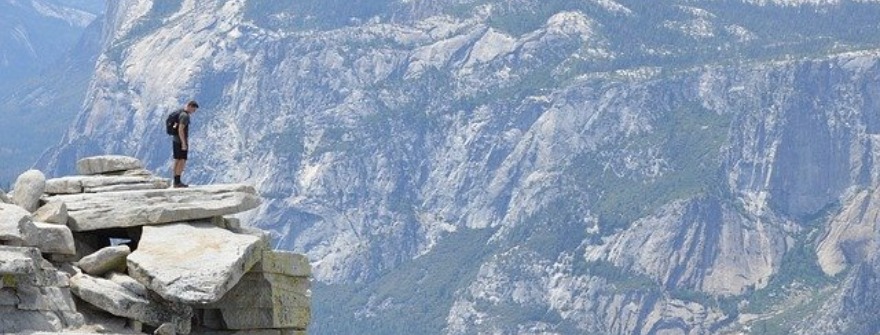Yosemite National Park is one of the world’s most dramatic geological spectacles. The Yosemite Valley, just seven miles long, is walled by near-vertical three thousand foot cliffs, streaked by tumbling waterfalls. At ground level, grassy meadows filled with oak, cedar and fir trees cover this park. You can visit any time of the year, even in winter when the waterfalls ice up and the trails are blocked by snow.
Yosemite National Park preserves a portion of the Sierra Nevada that stretches along California’s eastern flank. The park ranges from 2,000 feet above sea level to more than 13,000 feet. Major features include; Yosemite Valley, Yosemite Village, Upper Yosemite Falls, Bridal Veil Falls and the world’s largest granite monolith, El Capitan.
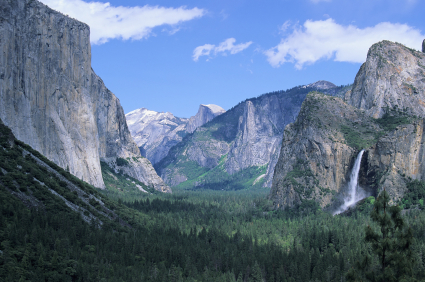
The three roads from the Central Valley end up in the center of the park’s 1200 square miles, in the natural splendor of the Yosemite Valley. This is the busiest part of the park, with Yosemite Village being the hub. One of the most popular trails is the Mist Trail, which winds up so close to Vernal Falls that during the snowmelt period hikers are drenched by it. Vernal Falls always has some water flowing over it, but the falls are at their most dramatic in the spring.
The more strenuous trail to Upper Yosemite Falls leads up along a steep path from behind the Camp 4 campground. This almost continuous ascent is tiring, but you are rewarded by fine views over the valley on the way up, and a chance to appreciate the power of the water as it crashes almost 1500 ft in a single cascade. A mile further, you reach the top of the falls, where there are more spectacular views and spots for a much-deserved picnic. The two major cliffs visible from the valley are the 3600 ft El Capitan and Half Dome, the sheerest cliff in North America.
The most spectacular views of the Yosemite Valley are from Glacier Point, the top of a 3200 ft, almost vertical cliff. It’s possible to get there on foot using the Four-mile trail, but the less inclined can take the bus. The valley floor lies directly beneath the viewing point, and there are tremendous views across to Half Dome and the distant snowcapped peaks of the High Sierras.
Attractions
Yosemite boasts a number of landmarks that have been popular with visitors since the park’s inception. One of the most famous sights in Yosemite is El Capitan, a mountain that retains the distinction of the largest granite monolith in the world. This Yosemite treasure was immortalized by Ansel Adams in several photographs and continues to inspire awe and reverence in visitors. El Capitan is also a preferred rock climbing destination, drawing hundreds of experienced climbers every year to its magnificent face. The Half Dome is another impressive rock formation in the park, towering more than 4,000 feet (1219 meters) above the Valley Floor. It is possible to hike to the top of this rock, and there are climbing opportunities on the face of the Half Dome as well.
Yosemite is also known for its breathtaking waterfalls, of which there are several. Yosemite and Bridalveil are two of the more notable waterfalls, each offering displays of awesome power that demonstrate the remarkable force of nature. Yosemite Falls is 2425 feet (739 m) high and is usually dry by August. Spring is the best time to see this waterfall as the run-off from the surrounding mountains bolsters the volume of water significantly. A famous ice spire forms in winter as mist from the falls accumulates and creates a massive cone. Holding the title of the world’s fifth-largest waterfall, Yosemite Falls is actually made up of three different falls, the Upper Yosemite Falls (1430ft./436 m), the middle cascades (675ft./206 m) and the Lower Yosemite Fall (320ft./98 m). In contrast to the height of Yosemite Falls, the equally impressive Bridalveil Falls drops just 620 feet or 189 meters. Easily accessible, this waterfall can be seen year-round and is the first set of falls that visitors see when entering the park from Fresno or Merced.
Many visitors come to Yosemite in search of the legendary stands of sequoias, groves of old-growth trees that are the largest of all living things. The grandeur of these trees is known the world over, rivaling the rainforests in terms of famous arbors. The Mariposa Grove is the most visited stand of Sequoias and is located near the park’s South Entrance. This stand of trees is among the most majestic and the most accessible to visitors, with roughly 500 mature giant sequoias. Guests can either hike up the trails or buy a ticket for a ride on one of the open-air trams that go up to the groves.
Spring Climbing in Yosemite
Springtime was made for climbers. It’s too early to head up to the high country for alpine routes, but some of the classic meccas offer cool, dry rock, and mild temperatures. And if you visit before the pre-summer rush, you can enjoy some of these climbing institutions without hoards of tourists or fellow climbers.
Climbers know there is no bad time to visit the great walls of Yosemite, but springtime – before the tourists, before the bugs, and before the scorching summer heat – is darn close to paradise. Yosemite is home to the awe-inspiring 3,000-foot El Capitan and Half Dome, whose beauty captivated the imagination of explorer John Muir in 1869, and over a half century later, served as an outdoor studio for photographer Ansel Adams. Climber are also drawn to its inaccessible spires and shimmering rock walls. In fact, Yosemite has been attracted climbers since 1869!
While Yosemite has long been known as the stomping ground for some of the world’s best rock climbers, insiders know that the Valley actually has an abundance of routes of beginning and intermediate ability. Routes such as the Snake Dike (5.7), the Nutcracker (5.8) and Reed’s Direct (5.9) are worthy adventures for even expert climbers. And if these don’t make your heart beat faster, there’s always the classic Outer Limits (10b).
For climbers without a partner, consider hiring a guide for the day – a great way to get lots of air under your feet, fast! The Yosemite Mountaineering School (209-372-8344), Yosemite National Park, California, charges $70 per person for a basic rock climbing class; guided climbs run $135 per day, with “Extreme Days” costing $290.
Camping is tight in Yosemite, but you should have good luck finding a spot if you beat the summer rush. Camp Four (Sunnyside Campground) is where most climbers stay, but expect an international climber’s refugee camp, with ghetto blasters galore, but plenty of local color. Sites are available on a first-come, first-served system, so get there early. Climbers with spare pocket change should consider a night in the Ahwanee (rooms start at $265). A less expensive alternative is the Wawona Lodge; built in 1879, it’s the oldest lodge in the park (rooms start at $94). After climbing, cool down and have a cold beer at Degnans’s Deli in Yosemite Village or down at the boulders in Camp Four. The Loft at Yosemite Village has the best cheeseburger west of the Rockies; the Mountain Room Bar is the traditional watering hole for Yosemite locals.
Entering Yosemite Valley
The Valley of Yosemite is something you will never forget. After trekking through the beginning of the park to the Valley viewpoint, you can see the entire panorama displayed before you…Half Dome, Glacier Point, El Capitan, and the Merced River.
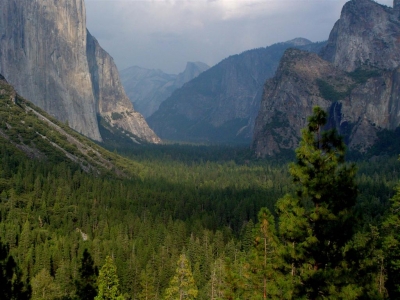
Read this before booking your trip!
Much of Yosemite is closed to vehicles throughout the year. Tioga Pass road is often closed until May or June until snow melts and roads are cleared. Every year snowfall and rock debris has to be cleared from all of the roads for safe travel.
Upper and Lower Yosemite Falls
Widely acclaimed as the sixth highest waterfall in the world, Yosemite Falls is located in the Sierra Nevada Mountain range inside Yosemite National Park in California. With the water flow running at its peak during the months of spring, it is one of the most spectacular sights in the United States.
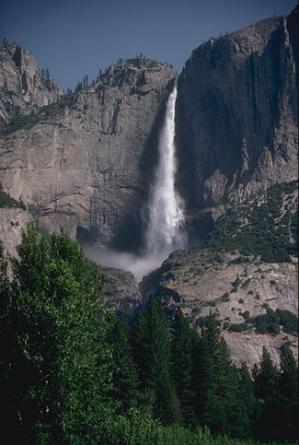
Yosemite Falls is a three-stage drop with a total height of 2425 ft (739 m) from the apex of the upper falls to the base of the lower falls. The Yosemite Creek rapids, while winding through the turns of Eagle Creek Meadow, hurl themselves down from a height of 1430 ft (425 m) into the Yosemite Valley with deafening noise and enormous force forming the Upper Yosemite Falls. Following the drop, there are a series of cascades or smaller plunges that together form a second drop with a height equal to 675 ft (205 m). Following the cascade, there is another drop of 320 ft (97 m) called the Lower Yosemite Falls. The Yosemite Creek re-forms at the base of the Lower Yosemite Falls and runs into the Merced River.
There are spectacular vantage points found along the trail of Yosemite Falls. Hikers can climb to the top of the falls following a 3.5-mile strenuous, steep, dangerous and slippery hiking path that starts at a short distance from the west of the Lower Falls. Apart from this, there are various trail routes from the Tioga Road that lead to the apex of the Falls. Lower Yosemite Falls can be reached following a quarter-mile trail that starts from the parking area on the northern side of Yosemite Lodge in the valley.
El Capitan
Situated at an elevation of 7,569 ft (2,307 m) above sea level, El Capitan is a vertical granite rock formation located on the northern side of Yosemite Valley. Claimed as the largest exposed block of granite on the surface of Earth, El Capitan is the most favored rock climbing challenge around the world.
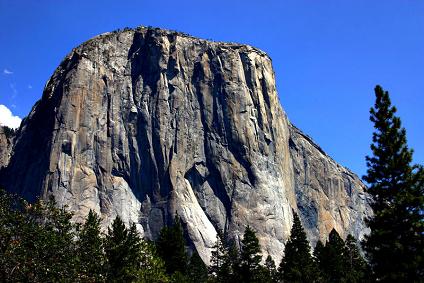
According to historians, El Capitan is a result of Sherwin Glaciations that occurred in the Sierra Nevada Range around 1.3 million years ago. This monumental rock formation is basically comprised of three types of granite, including El Capitan granite, diorite, and Taft granite on the uppermost portion of the cliff.
There are around 70 routes in which one can climb El Capitan. One of the most famous climbing routes is The Nose, which is a distinct projection between the southeast and southwest faces. Warren J. Harding, Wayne Merry, and George Whitmore climbed the rock through The Nose route in 1958 using siege tactics. Since then several climbers have successfully conquered the majestic giant. Some of the other prominent routes on El Capitan include the Salathe Wall on the southwest face, North America wall on the southeast face, Dihedral Wall, West Buttress, Muir Wall, Zodiac, and the Pacific Ocean Wall. Each route has its own individual thrills and spills.
Spring is a perfect time to climb the rock. During summer, El Capitan gets extremely hot, making it impossible to climb. One of the biggest dangers that climbers can face during the months of winter is the extremely low temperatures.
El Capitan was once a popular destination for base jumping. However, the National Park Service has banned this sport due to several fatal accidents.
Half Dome
Situated at an elevation of 8,836 ft above sea level, Half Dome is one of the most prominent locations inside the Yosemite National Park in California. It is a granite-rock formation located at the eastern end of the Yosemite Valley in the Sierra Nevada Mountain range. Historians consider Half Dome to be a cretaceous rock formation believed to have formed some 93 million years ago.
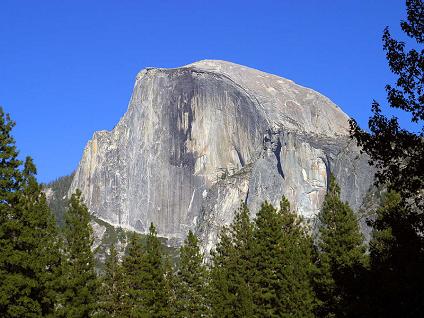
Half Dome is one of the most popular rock climbing spots in the United States. This rock was declared as a perfectly inaccessible cliff during the 1870s. However, George Anderson was the first successful rock climber to have ascended Half Dome in 1875. Since then, thousands of hikers from around the world have come to conquer it. There are various rock climbing routes originating from Half Dome’s North-west, South and West face.
The original name of Half Dome was “Tis-sa-ack”, which meant Cleft Rock in the Native American language. The rock is at an elevation of 4,800 ft (1,463 m) from the Yosemite Valley floor. The journey to Half Dome is a 17 mile (27.4 km) circuitous route from the valley floor that can be generally completed within 10 to 12 hours. Trekkers can follow the Mist Trail or the John Muir Trail and reach Nevada Falls. The distance through the Mist Trail is 1.2 miles less than John Muir Trail. Another important trail is the Half Dome Cables Route Hike, whose length is approximately 5 miles (8 km) from the floor of the valley.
The summit of the rock is a remarkable place to reach, offering an exquisite glimpse of the surroundings including the gorgeous Little Yosemite Valley and the valley floor.
Glacier Point
Situated at an elevation of 7,214 ft (2,199 m) above sea level, Glacier Point is the most majestic location inside Yosemite National Park. Glacier Point is located 3,214 ft (980 m) above the floor of Yosemite Valley and offers a glorious view of the entire Yosemite National Park. The view stretches over the numerous lofty mountain ranges of the Sierra Nevadas, lush meadows around the Merced River, the gorgeous Yosemite Falls, Half Dome, clearly visible Vernal Falls, Nevada Falls, the beautiful Yosemite Valley, the steep canyon of Tenaya Creek and Clouds Rest.
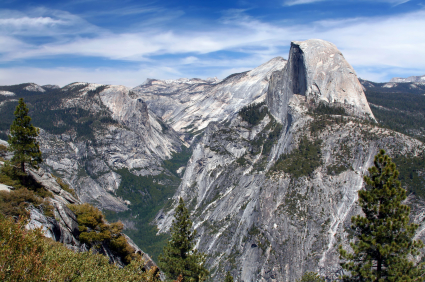
Glacier Point can be conveniently reached using two distinct routes. One can take a route from the valley through Glacier Point Road. There are shuttle buses going on this route that takes an hour to make the trip. Open from June to October, this route is the most favored one with tourists who flock to this place in summer. Another important trail point is the Four Mile Trail, which is relatively hazardous and is closed to tourists from December to May. Both these routes are widely known for their wilderness as they are densely forested. Much to the delight of trekkers, these routes also contain grassy meadows, small lakes, mountain streams, and rocky outcrops.
Glacier Point has a beautiful camping point called Bridalveil Creek. This camping ground consists of 110 well-separated sites consisting of fire grilles, tables, and benches. A creek that slowly runs alongside the camping ground joins up with the Merced River in Yosemite Valley.
Mariposa Grove
Located in Yosemite National Park, Mariposa Grove features a forest of sequoia trees. The famous Grizzly Giant stands in the park and is estimated to be around 2700 years old. Also located in the park is the Tuolumne Meadows, which includes a stretch of colorful flowers.
History
White settlers first came to the area in 1833, encountering American Indians that were primarily of Miwok ancestry. The tribe lived off the land until the gold rush, 20 years later, brought many miners and other non-natives to the area searching their fortune. With the influx of settlers came disease and encroachment that left the population of the Miwoks significantly diminished. As the tribes sought to protect their homeland, the U.S. Army moved swiftly to quash any resistance, and by 1851 the Miwoks had succumbed to American domination.
Entrepreneurs took the helm in Yosemite following the gold rush, and development in the park began on a scale that would soon prove to be unsustainable. Calls for protection of the area were first voiced in the early 1860s, with President Lincoln signing a bill in 1864 in Washington making Yosemite part of an “inalienable public trust”. It was this legislation—the first granting protection to lands for the enjoyment of all people—that paved the way for the creation of the National Park Service in the United States. Though Yosemite wasn’t the first National Park, it played a vital role in ensuring that such lands would be enjoyed by subsequent generations. Yosemite was granted park status in 1890, followed by the first rangers who set up camp in the area in 1914.
Accommodations
Most of the accommodation in the park comes in the form of campgrounds. Of the 13 campgrounds in the park, seven are on a reservation system while the rest is allotted to the first to arrive. Campsites can be reserved by contacting the park office or through the National Park Service website. It is recommended that campers wishing to reserve a site do so several months in advance to guarantee that their request can be accommodated.
Aside from camping, there are several hotels and lodges in Yosemite National Park that offer overnight berths. Some of these lodgings are open only during the summer months, however, visitors wishing to explore Yosemite in the winter can be accommodated as well. One of the more well-known lodgings in Yosemite is the Ahwahnee Hotel. Built in 1927 to entice affluent visitors, the Ahwahnee was originally meant as a showpiece to encourage wealthy patrons to endorse the preservation of Yosemite. Today, the hotel is a luxury accommodation that features a host of amenities and services, from a heated outdoor pool to cozy fireplaces to comfortable parlors. There is also a restaurant on the premises that cater to guests.
Another historic accommodation in Yosemite National Park is the Wawona Hotel, comprised of 104 rooms in six buildings. Though not as luxurious as the Ahwahnee, the Wawona offers attractive rooms for visitors not willing to “rough it”.
Visit Yosemite in Style
Remember that the summer months and holiday seasons can see a very busy Yosemite National Park – parking can be difficult in July and August for example. You might be better off avoiding the crowds and taking your vacation in the spring or autumn when the weather is still pretty dry.
There are some really lovely, luxury hotels in Yosemite National Park. Consider either the Château du Sureau or better still The Ahwahnee which is in the Park itself.
Getting There
Yosemite National Park’s nearest airports are at Fresno, Merced, and Modesto – all are about 90 minutes to two hours’ drive away. There’s a greater range of flights to San Francisco though – from where the travel time is 4 hours. It’s also possible to take the train from San Francisco, though it’s not as quick as driving.
Tips for Travelling Onwards
San Francisco and other travel highlights in California are easy and convenient to combine with a vacation to the Yosemite National Park. Alternatively, consider traveling further East to Las Vegas or even the Grand Canyon.
Yosemite Travel Time Estimates
>Here are the distances from locations to Yosemite National Park drive time. Traffic time not included!
- San Diego to Yosemite National Park: 430 mi – about 7 hours 15 mins
- Los Angeles to Yosemite National Park: 310 mi – about 5 hours 19 mins
- San Francisco to Yosemite National Park: 189 mi – about 3 hours 58 mins
- Fresno to Yosemite National Park: 92.6 mi – about 2 hours 1 min
- Portland, Oregon to Yosemite National Park: 741 mi – about 12 hours 22 mins
- Seattle, Washington to Yosemite National Park: 914 mi – about 15 hours 9 mins
- Las Vegas, Nevada to Yosemite National Park: 416 mi – about 7 hours 50 mins
- Phoenix, Arizona to Yosemite National Park: 680 mi – about 10 hours 43 mins
- Salt Lake City, Utah to Yosemite National Park: 615 mi – about 10 hours 53 mins
- Lake Tahoe, California to Yosemite National Park: 216 mi – about 4 hours 55 mins
- Giant Sequoia National Park to Yosemite National Park: 155 mi – about 3 hours 2 mins
